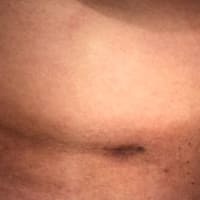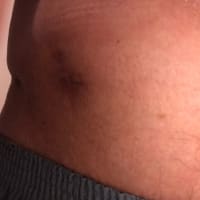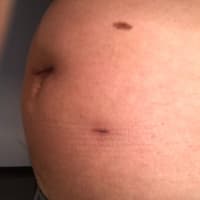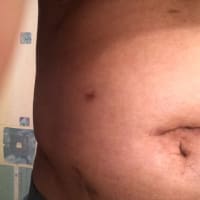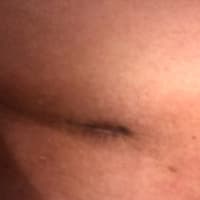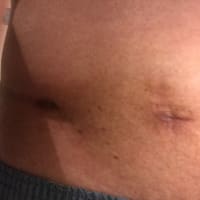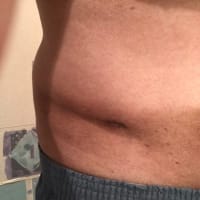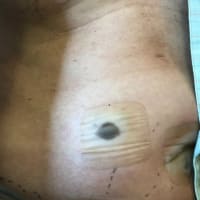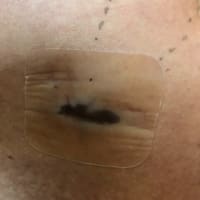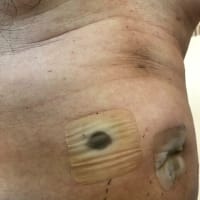
(オリジナルは7月9日に掲載した内容を一部修正追記しました)
添付図は、海外文献「Radiologic Findings and Curve Progression 22 years after
Treatment for Adolescent Idiopathic Scoliosis」(思春期特発性側わん症を治療
22年後のカーブ進行のレントゲン観察)のなかにあった図を撮影したものです。
側彎症による脊柱固定手術後にも、ある程度のカーブ進行はあります。
それを correction loss(コレクションロス) 矯正角度の損失というような和訳に
なると思います。損失とはいいましても、この図を見ていただきますとわかります
ように、そのカーブの戻りは、支障をきたすような大きなものではありません。
図の見方は、縦がコブ角度、横が時間軸を示しています。
例えば、術前80度→術直後42~43度→最終治療時40度→10数年後50度弱
60度程で手術をしますと、同じようなダウン~若干のアップがあって30数度前後
もちろん、手術の成果には個人差があります。その個人差の幅が点の上下について
いる線であらわされています。60度程で手術してのベストケースは、20度弱で落ち着いて
いる人もいます。
カーブが悪化してから手術すれば、手術の成果もおおきな期待はもてません。
どのタイミングで手術するか、ということは、このような、手術後の長期成績など
ももとにして、検討する必要があります。
--------------------------------------------------------------------------
(追記)
この文献はいまから30年ほど前にスゥェーデンで行われた側弯症患者に対する手術
治療と装具治療を20年以上にわたって経過観察したデータです。使用されている
のは脊柱固定術を側彎症手術のスタンダードにすることに貢献したハリントンロッド
によるものです。いわば、初期の側弯症手術の時代での治療成績を示していること
になります。
脊柱固定手術は用いられるデバイスの改良の歴史でもあるのですが、このハリントンロッド
は、フック(鉤)を骨の一部にひっかけて、Distraction(曲がった脊柱を頭側と尾側
に押し広げる)という操作によりカーブを矯正する、というシステムです。
このハリントンロッド自体はすでに過去のものとなっていますが、骨にかける
フック(鉤)を使用するというアイデアや、曲がった脊柱を伸ばす物理作用という
コンセプトは現在使用されているデバイスにも受け継がれています。
海外文献紹介
専門誌 Spine 2001 Vol 26, Number 5
タイトル Radiologic Findings and Curve Progression 22 years after
Treatment for Adolescent Idiopathic Scoliosis : Comparison of Brace and
Surgical Treatment with Matching Control Group of straight individuals.
思春期特発性側わん症を治療したブレース患者と手術患者の比較
22年後のカーブ進行のレントゲン観察
研究デザイン:1968年から1977年に連続して治療した思春期特発性側わん症患者の
フォローアップ。この研究では156人がハリントンロッド手術を受け、127人が装具
療法を受けた。
目的: 治療終了後少なくとも20年以上経過してのレントゲン観察とカーブ進行の
長期アウトカムを調査する。
背景: 異なる治療方法のアウトカムを比較するうえではレントゲン観察は重要で
ある。これまでの研究では、ブレース治療患者の場合は、治療後カーブが少しづつ
進むことが述べられてきた。一方、脊柱固定手術患者の場合はそれは指摘されて
こなかった。
方法: 283人の患者のうち、252人がバイアスを有しないひとりの医師によって臨床
とレントゲンによる経過観察が実施された。(91%が手術患者、87%が装具患者)
この評価は、チャートレビュー、質問票、臨床評価、そして立位で正面と側面での
レントゲン撮影を実施した。カーブの大きさはコブ法を用いて計測した。変性や
他の合併症なども記録した。
結果: 手術患者群の平均観察期間は23年、装具治療患者群は22年である。すべての
手術患者では、3.5度のカーブが進行が見られた。装具患者では7.9度のカーブ進行
がみられた。5人の装具患者で20度以上の進行があった。手術による合併症率は
きわめて少なかった。手術患者の3人で偽関節、4人でフラットバックシンドローム
となった。8人でカーブ進行に関連した追加手術を行った。腰椎の後弯変形は、手術
患者のほうが装具患者よりも少なかった。(平均33度 vs 45度)
結論: 治療終了から20年以上が経過しても、カーブの大きな進行は見られなかった
手術による合併症も少なかった。老化による変性疾患のあらわれは、どちらの群
でもみられた。
Study Design. This study is a follow-up investigation for a consecutive
series of patients with adolescent idiopathic scoliosis treated between
1968 and 1977. In this series, 156 patients underwent surgery with
distraction and fusion using Harrington rods, and 127 were treated
with brace. Objectives. To determine the long-term outcome in terms of
radiologic findings and curve progression at least 20 years after
completion of the treatment. Summary of Background Data. Radiologic
appearance is important in comparing the outcome of different treatment
options and in evaluating clinical results. Earlier studies have shown a
slight increase of the Cobb angle in brace-treated patients with time, but
not in fused patients.
Methods. Of 283 patients, 252 attended a clinical and radiologic follow-up
assessment by an unbiased observer (91% of the surgically treated and 87%
of the bracetreated patients). This evaluation included chart reviews,
validated questionnaires, clinical examination, and fulllength standing
frontal and lateral roentgenographs. Curve size was measured by the Cobb
method on anteroposterior roentgenograms as well as by sagittal contour
and balance on lateral films. The occurrence of any degenerative changes or
other complications was noted. An age- and gender-matched control group of
100 individuals was randomly selected and subjected to the same
examinations.
Results. The mean follow-up times were 23 years for surgically treated
group and 22 years for brace-treated group. The deterioration of the curves
was 3.5° for all the surgically treated curves and 7.9° for all the
brace-treated curves (P , 0.001). Five patients, all brace-treated, had a
curve increase of 20° or more. The overall complication rate after surgery
was low: Pseudarthrosis occurred in three patients, and flat back syndrome
developed in four patients. Eight of the patients treated with fusion
(5.1%) had undergone some additional curve-related surgical procedure. The
lumbar lordosis was less in the surgically treated than in the
brace-treated patients or the control
Both surgically treated andbrace-treated patients had more degenerative
disc changes than the control participants (P,0.001), but no significant
differences were found between the scoliosis groups. No statistically
significant difference in terms of radiographically detectable degenerative
changes in the unfused lumbar discs was found between patients fused below
L3 or those fused to L3 and above (P 5 0.22). A study on intra- and
interobserver measurements of kyphosis, lordosis, and sagittal vertical
axis on two films for each patient demonstrated that the repeatability
of measuring sagittal plumbline on two different lateral radiographs, with
patients moving between radiograms, was unreliable for comparison.
Conclusions. Although more than 20 years had passed since completion of the
treatment, most of the curves did not increase. The surgical complication
rate was low. Degenerative disc changes were more common in both patient
groups than in the control group
////////////////////////////////////////////////////////////////////////
ブログ内の関連記事
「側わん症 手術のタイミングを逃さない事 ! それは親の責任です」
http://blog.goo.ne.jp/august03/e/bd267016fa1d30df925ca3a30a51ef4f
添付図は、海外文献「Radiologic Findings and Curve Progression 22 years after
Treatment for Adolescent Idiopathic Scoliosis」(思春期特発性側わん症を治療
22年後のカーブ進行のレントゲン観察)のなかにあった図を撮影したものです。
側彎症による脊柱固定手術後にも、ある程度のカーブ進行はあります。
それを correction loss(コレクションロス) 矯正角度の損失というような和訳に
なると思います。損失とはいいましても、この図を見ていただきますとわかります
ように、そのカーブの戻りは、支障をきたすような大きなものではありません。
図の見方は、縦がコブ角度、横が時間軸を示しています。
例えば、術前80度→術直後42~43度→最終治療時40度→10数年後50度弱
60度程で手術をしますと、同じようなダウン~若干のアップがあって30数度前後
もちろん、手術の成果には個人差があります。その個人差の幅が点の上下について
いる線であらわされています。60度程で手術してのベストケースは、20度弱で落ち着いて
いる人もいます。
カーブが悪化してから手術すれば、手術の成果もおおきな期待はもてません。
どのタイミングで手術するか、ということは、このような、手術後の長期成績など
ももとにして、検討する必要があります。
--------------------------------------------------------------------------
(追記)
この文献はいまから30年ほど前にスゥェーデンで行われた側弯症患者に対する手術
治療と装具治療を20年以上にわたって経過観察したデータです。使用されている
のは脊柱固定術を側彎症手術のスタンダードにすることに貢献したハリントンロッド
によるものです。いわば、初期の側弯症手術の時代での治療成績を示していること
になります。
脊柱固定手術は用いられるデバイスの改良の歴史でもあるのですが、このハリントンロッド
は、フック(鉤)を骨の一部にひっかけて、Distraction(曲がった脊柱を頭側と尾側
に押し広げる)という操作によりカーブを矯正する、というシステムです。
このハリントンロッド自体はすでに過去のものとなっていますが、骨にかける
フック(鉤)を使用するというアイデアや、曲がった脊柱を伸ばす物理作用という
コンセプトは現在使用されているデバイスにも受け継がれています。
海外文献紹介
専門誌 Spine 2001 Vol 26, Number 5
タイトル Radiologic Findings and Curve Progression 22 years after
Treatment for Adolescent Idiopathic Scoliosis : Comparison of Brace and
Surgical Treatment with Matching Control Group of straight individuals.
思春期特発性側わん症を治療したブレース患者と手術患者の比較
22年後のカーブ進行のレントゲン観察
研究デザイン:1968年から1977年に連続して治療した思春期特発性側わん症患者の
フォローアップ。この研究では156人がハリントンロッド手術を受け、127人が装具
療法を受けた。
目的: 治療終了後少なくとも20年以上経過してのレントゲン観察とカーブ進行の
長期アウトカムを調査する。
背景: 異なる治療方法のアウトカムを比較するうえではレントゲン観察は重要で
ある。これまでの研究では、ブレース治療患者の場合は、治療後カーブが少しづつ
進むことが述べられてきた。一方、脊柱固定手術患者の場合はそれは指摘されて
こなかった。
方法: 283人の患者のうち、252人がバイアスを有しないひとりの医師によって臨床
とレントゲンによる経過観察が実施された。(91%が手術患者、87%が装具患者)
この評価は、チャートレビュー、質問票、臨床評価、そして立位で正面と側面での
レントゲン撮影を実施した。カーブの大きさはコブ法を用いて計測した。変性や
他の合併症なども記録した。
結果: 手術患者群の平均観察期間は23年、装具治療患者群は22年である。すべての
手術患者では、3.5度のカーブが進行が見られた。装具患者では7.9度のカーブ進行
がみられた。5人の装具患者で20度以上の進行があった。手術による合併症率は
きわめて少なかった。手術患者の3人で偽関節、4人でフラットバックシンドローム
となった。8人でカーブ進行に関連した追加手術を行った。腰椎の後弯変形は、手術
患者のほうが装具患者よりも少なかった。(平均33度 vs 45度)
結論: 治療終了から20年以上が経過しても、カーブの大きな進行は見られなかった
手術による合併症も少なかった。老化による変性疾患のあらわれは、どちらの群
でもみられた。
Study Design. This study is a follow-up investigation for a consecutive
series of patients with adolescent idiopathic scoliosis treated between
1968 and 1977. In this series, 156 patients underwent surgery with
distraction and fusion using Harrington rods, and 127 were treated
with brace. Objectives. To determine the long-term outcome in terms of
radiologic findings and curve progression at least 20 years after
completion of the treatment. Summary of Background Data. Radiologic
appearance is important in comparing the outcome of different treatment
options and in evaluating clinical results. Earlier studies have shown a
slight increase of the Cobb angle in brace-treated patients with time, but
not in fused patients.
Methods. Of 283 patients, 252 attended a clinical and radiologic follow-up
assessment by an unbiased observer (91% of the surgically treated and 87%
of the bracetreated patients). This evaluation included chart reviews,
validated questionnaires, clinical examination, and fulllength standing
frontal and lateral roentgenographs. Curve size was measured by the Cobb
method on anteroposterior roentgenograms as well as by sagittal contour
and balance on lateral films. The occurrence of any degenerative changes or
other complications was noted. An age- and gender-matched control group of
100 individuals was randomly selected and subjected to the same
examinations.
Results. The mean follow-up times were 23 years for surgically treated
group and 22 years for brace-treated group. The deterioration of the curves
was 3.5° for all the surgically treated curves and 7.9° for all the
brace-treated curves (P , 0.001). Five patients, all brace-treated, had a
curve increase of 20° or more. The overall complication rate after surgery
was low: Pseudarthrosis occurred in three patients, and flat back syndrome
developed in four patients. Eight of the patients treated with fusion
(5.1%) had undergone some additional curve-related surgical procedure. The
lumbar lordosis was less in the surgically treated than in the
brace-treated patients or the control
Both surgically treated andbrace-treated patients had more degenerative
disc changes than the control participants (P,0.001), but no significant
differences were found between the scoliosis groups. No statistically
significant difference in terms of radiographically detectable degenerative
changes in the unfused lumbar discs was found between patients fused below
L3 or those fused to L3 and above (P 5 0.22). A study on intra- and
interobserver measurements of kyphosis, lordosis, and sagittal vertical
axis on two films for each patient demonstrated that the repeatability
of measuring sagittal plumbline on two different lateral radiographs, with
patients moving between radiograms, was unreliable for comparison.
Conclusions. Although more than 20 years had passed since completion of the
treatment, most of the curves did not increase. The surgical complication
rate was low. Degenerative disc changes were more common in both patient
groups than in the control group
////////////////////////////////////////////////////////////////////////
ブログ内の関連記事
「側わん症 手術のタイミングを逃さない事 ! それは親の責任です」
http://blog.goo.ne.jp/august03/e/bd267016fa1d30df925ca3a30a51ef4f












